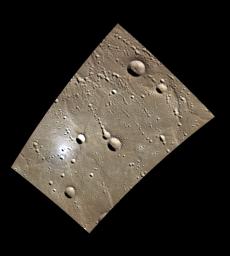This small, bright crater is located in the northern plains of Mercury, southeast of the crater Stieglitz. Though it is one of many craters in the 2-5 km size range in this image, most of the others are clearly members of crater chains, created in quick succession during secondary impacts. The crater in the western portion of the image stands out from its surroundings both due to its morphology and its freshness.
This image was acquired as part of MDIS's minimum-phase-angle color campaign. Near the north polar region, the incidence angle (measured from the vertical) is always fairly high because the Sun is low on the horizon. The minimum-phase-angle color campaign acquires images under conditions that minimize the shadows in an image by viewing the surface as nearly as possible from the same direction as the Sun's illumination, which minimizes the phase angle. Images are acquired through five of the WAC's narrow-band color filters, for regions north of 60° N, at an average resolution of 500 meters/pixel. The minimum-phase-angle color campaign began in March 2013.
Date acquired: July 04, 2014
Image Mission Elapsed Time (MET): 46773193, 46773184, 46773190
Image ID: 6618773, 6618770, 6618772
Instrument: Wide Angle Camera (WAC) of the Mercury Dual Imaging System (MDIS)
WAC filters: 9, 7, 6 (996, 748, 433 nanometers) in red, green, and blue
Center Latitude: 68.82°
Center Longitude: 71.79° E
Resolution: 273 meters/pixel
Scale: This image is roughly 225 km (140 mi.) from corner to corner.
Incidence Angle: 73.9°
Emission Angle: 45.8°
Phase Angle: 28.0°
The MESSENGER spacecraft is the first ever to orbit the planet Mercury, and the spacecraft's seven scientific instruments and radio science investigation are unraveling the history and evolution of the Solar System's innermost planet. During the first two years of orbital operations, MESSENGER acquired over 150,000 images and extensive other data sets. MESSENGER is capable of continuing orbital operations until early 2015.
For information regarding the use of images, see the MESSENGER image use policy.

 Planetary Data System
Planetary Data System












